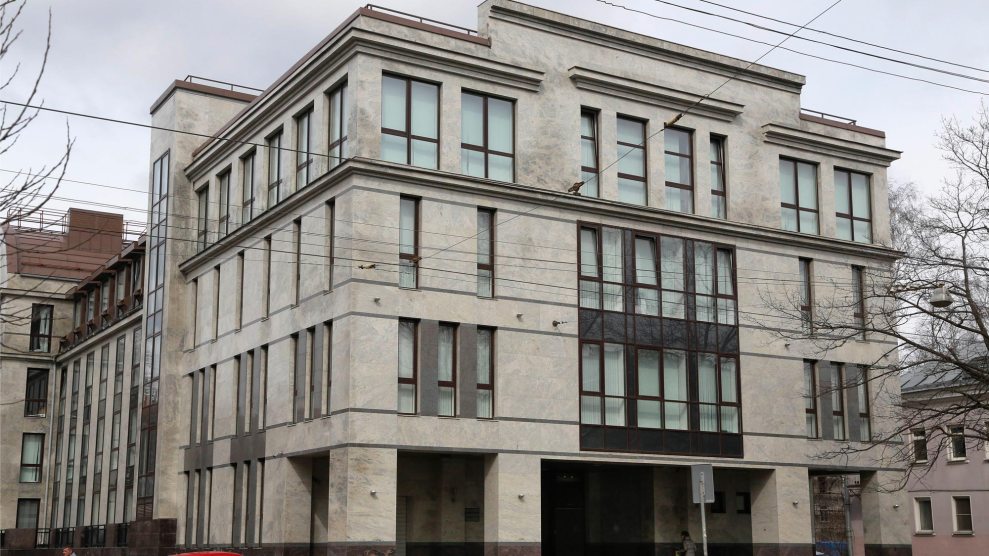
The four-story building in St. Petersburg believed to house the Internet Research AgencyDmitry Lovetsky/AP
A notorious Russian internet “troll factory” spent about $2.3 million during the 2016 election cycle to meddle in US politics, paying the salaries of 90 “US desk” employees who helped wage disinformation campaigns via social media that reached millions of Americans. The operation also contacted US activists directly and offered them thousands of dollars to organize protests on divisive issues, including race relations.
These revelations and many more came out in an investigation published on Tuesday by the Russian newspaper RBC about the Internet Research Agency (IRA), a tech firm based in St. Petersburg, Russia, that has developed a specialty in spreading pro-Kremlin messages in the West.
The IRA has been written about before by a number of news outlets, and by RBC itself. But this latest piece from RBC—a respected business newspaper in Russia known for angering the Kremlin with its reporting on Putin’s associates—is the first to home in on the IRA’s operations during the 2016 US election.
RBC’s investigation reveals an unprecedented level of detail about the money and staffing that went into IRA’s US-influence operation. Here are some of the key data points:
- By the middle of 2015, as the US election was ramping up, the IRA’s staffing had increased to between 800 and 900 people. The organization had also shored up its arsenal of media tools to include “videos, infographics, memes, reporting, news, analytical materials,” and more.
- In spring 2015, a number of IRA staffers held an experiment to see if they could successfully organize a live event in the US from behind their computer screens in St. Petersburg. They did this by targeting New Yorkers on Facebook and attempting to lure them to a specific event where they would receive a free hot dog. There were no actual hot dogs, but enough people showed up at the specified location to make the agency deem the experiment a success. “From this day, almost a year and a half before the election of the US President,” writes RBC, “the ‘trolls’ began full-fledged work in American society.”
- Within the next year, the staff of the IRA’s “American Department” grew threefold, increasing to between 80 and 90 people—about one-tenth of the entire agency.
- Three former employees of the IRA told RBC that the head of the American Department is a 27-year-old Azerbaijani man named Dzeihun Aslan, a point also corroborated by an internal Telegram chat obtained by RBC. (Aslan denied any such involvement in conversation with RBC.)
- By RBC’s calculations, the American Department spent about $1 million annually on salaries. The lowest-level employees were paid about 55,000 rubles ($960) per month, but also received bonuses based on “the reactions of participants in communities” they were targeting.
- RBC identified 118 Facebook, Twitter, and Instagram accounts linked to the IRA’s meddling in US politics.
- In September 2016, at the height of the US election season, the American Department posted more than 1,000 pieces of content per week, reaching between 20 and 30 million people that month.
- A source close to the leaders of the IRA told RBC that most of the agency’s American content had less to do with supporting a specific candidate than with promoting volatile social issues that happened to dovetail with Trump’s rhetoric. “There was no directive to ‘support Trump,'” one source told RBC. “Direct connections were drawn between societal problems and the actions of the ruling party at that time [the Democrats]. Hillary [Clinton] is the party’s representative, which means she’s also to blame.”
- RBC analyzed hundreds of IRA posts and found that Clinton was mentioned in the posts much more often than Trump.
- The total budget for promoting political ads to American audiences came to about $5,000 a month, or about $120,000 from June 2015 to May 2017. About half of that was spent on content aimed at sowing racial divisions.
- The IRA spent about $80,000 to support 100 US activists who organized 40 different protests across the United States.













